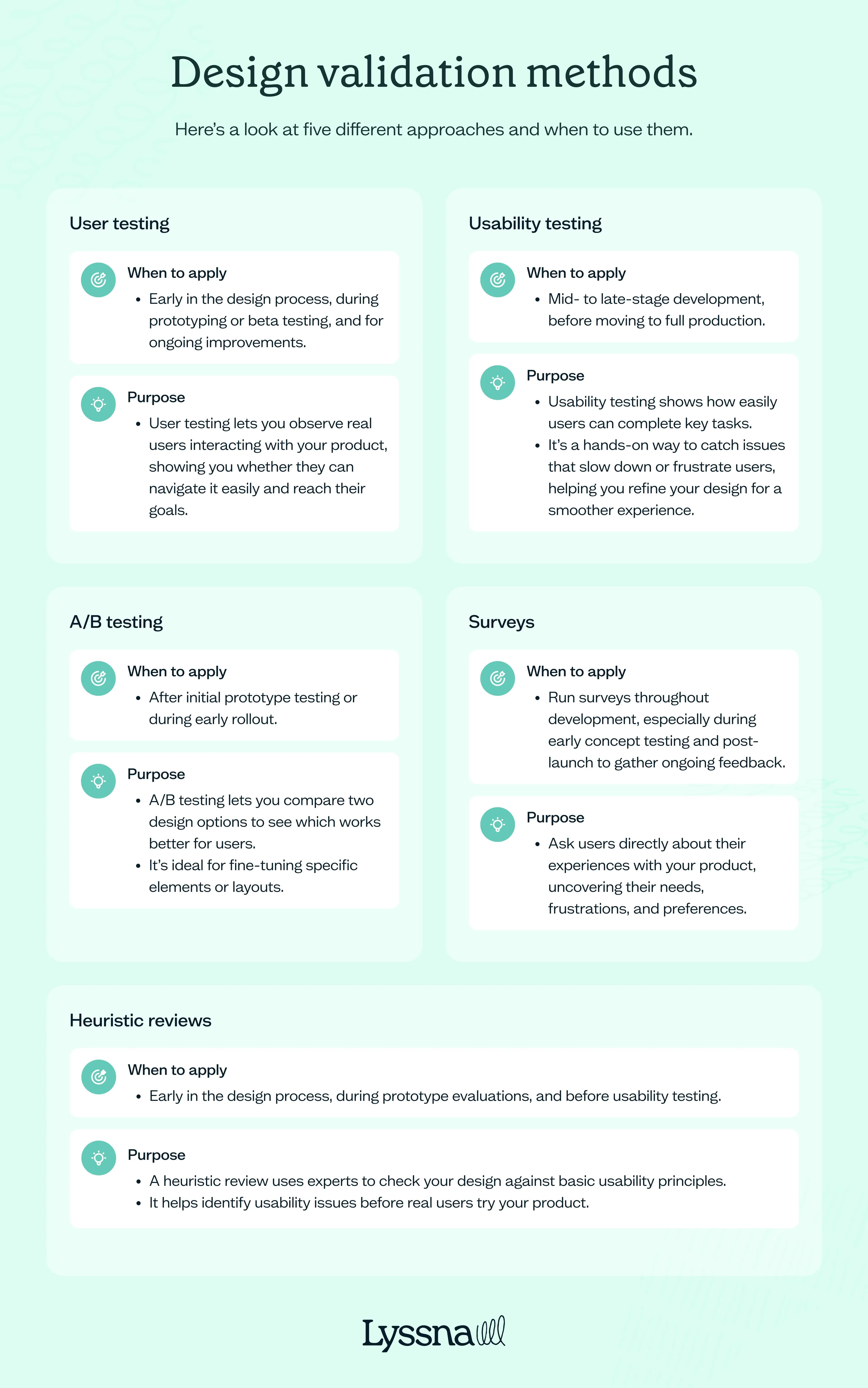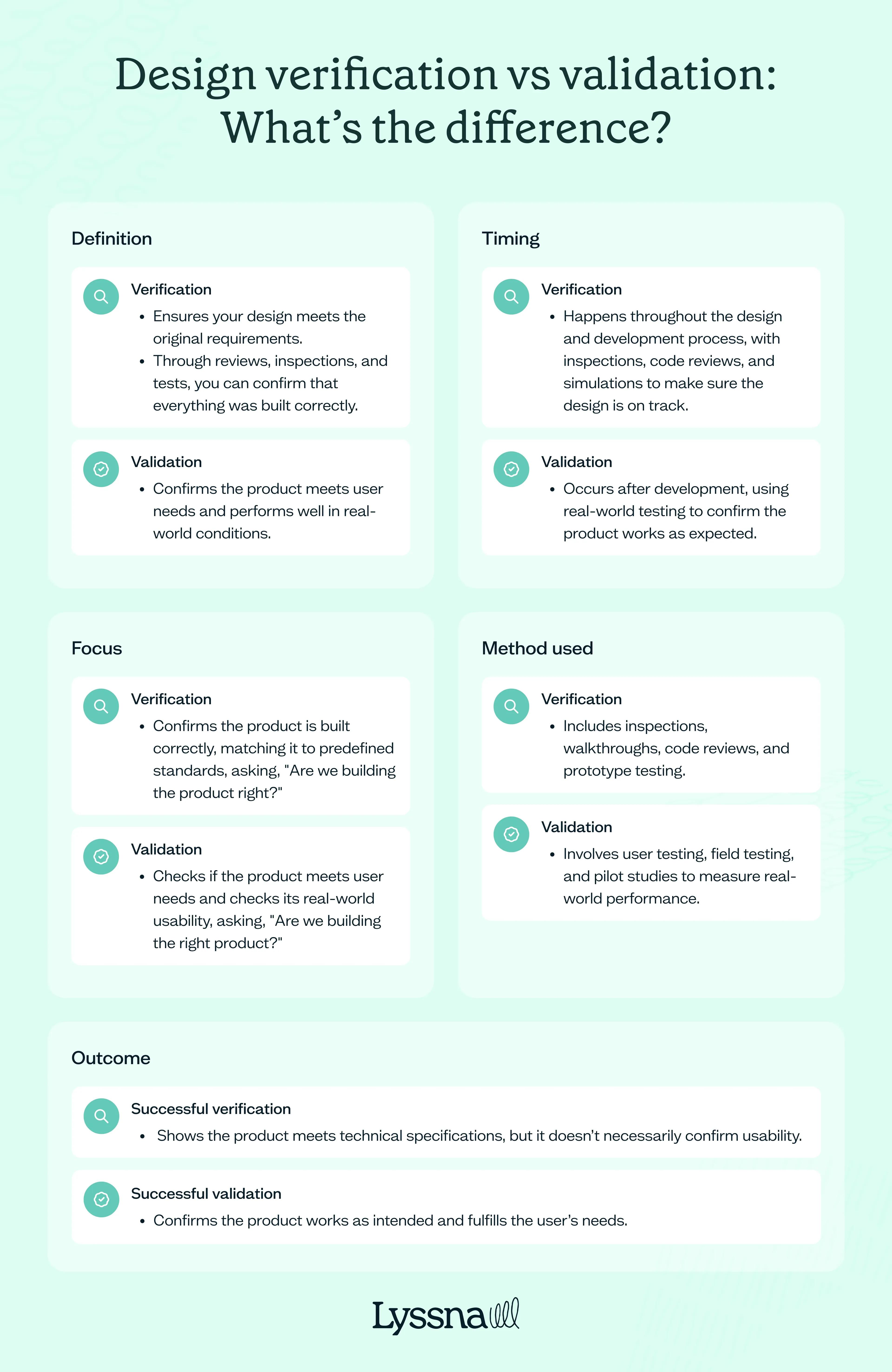Design validation is essential so that user experience designs fit well with users’ needs and preferences; it includes testing various design components to check their practicality, beauty, and ease of use. Well-carried-out design validation increases the probability of user satisfaction and mitigates the risk of the redesign.
To maintain competition, comprehend and ensure that the design fulfills market needs at the very start of the development process. As a result, it increases sales and profit for the company in the long term and tackles potential obstacles during the initial graphic design phase.
Understanding the Design Validation Process
Design validation is essential in ensuring the UX design process is completed thoroughly. Validation provides the system or product meets the expectations of the target audience.
It differs from verification as verification mainly focuses on the specification documents and checking if the product being built is being constructed according to those documents.
Validation, on the other hand, is focused primarily on the user experience aspect of the product by assessing the concepts, mockups, or even the finished product.
In the context of medical device development, understanding the design validation of medical device software is crucial. This ensures that the software meets quality and regulatory standards, providing a reliable user experience.
While measuring the effectiveness of design validation, there are set boundaries: user testing, heuristic practices, and essential feedback. User testing allows health professionals to introspect how a potential client uses a specific product and recognize which aspect would be beneficial to improve upon.
Source: lyssna

Heuristic methods are mainly based on expert principles concerning a website’s usability, whereas user feedback propels excellent insights into the characteristics and patterns the target group operates with. In cohesion, all these aspects endorse that certain boundaries exist and can be exceeded if a product is expertly designed.
In solving the problems associated with UX Design, teams will have a better chance of avoiding product failure. They will also be able to save some costs associated with redesigning the product.
A better approach will be made in terms of UX design. By definition, validation links the raw, conceptual ideation and the final user interface by ensuring that the result is practical, motivating, and pleasing to the target users.
Definition and Importance
Design validation is a critical process in the design thinking process that ensures a product or service meets the needs and expectations of its users. It involves rigorous testing and validation to confirm that the design is functional, usable, and fulfills its intended purpose.
This process is particularly vital in medical device development, where the stakes are high, and the margin for error is minimal.
Ensuring that a medical device is safe, effective, and meets all required specifications is paramount. Through design validation, developers can identify and rectify potential issues early, ensuring that the final product not only complies with regulatory standards but also delivers a seamless user experience.
Design Verification vs. Validation
Design verification and design validation are two distinct yet complementary processes in the development lifecycle. Design verification is the process of confirming that a design meets the specified requirements.
It involves checking that the design output aligns with the design input, ensuring that all specified criteria are met.
On the other hand, design validation focuses on confirming that the design meets user needs and intended use. It goes beyond mere specifications to assess whether the final product is practical and satisfactory for the end user.
In essence, while design verification ensures that the product is built correctly, design validation ensures that the right product is built.
Source: lyssna

Pre-validation Preparation
Establishing Clear Objectives and Design Inputs
To have unambiguous goals for the validation process, one must first understand the reason for and the scope of the evaluation. Teams should set a validation aim, such as checking out users' usability, functionality, or satisfaction. Each goal must be backed up with definite criteria for determining success in that goal.
Moreover, ensuring that the validation measures correspond to a more general goal guarantees that the process results are helpful at the higher levels of the organization.
Finally, having such hypotheses allows for their verification, thus allowing teams to test some of their assumptions and improve the product according to the data received. Such a sequence of actions enables teams to have a clear validation plan and goals while carrying out the process.
Identifying User Validation Methods
One must carefully integrate qualitative and quantitative approaches to determine the ideal validation methods. On one hand, qualitative methods like user interviews, focus groups, and usability tests provide thorough feedback about a user’s actions, intentions, and obstacles faced.
These methods effectively obtain complex feedback and generate ideas for new solutions. In contrast, quantitative methods, such as surveys, tracking analytics, and even A-B testing, offer significant amounts of data that could be used to determine patterns, confirm theories, and assist in decision-making based on statistical measures.
In addition to these methods, executing detailed test procedures is crucial to ensure the accuracy and reliability of design requirements during the verification process.
These procedures help document results, identify defects, and maintain thorough records to demonstrate compliance with established design inputs and outputs.
The chosen verification technique is filtered through the objective of the project and the phase the project is at within its life cycle. During the initial phases of the project, ideation and prototyping may heavily rely on qualitative methods. At the same time, in later stages, implementation, for example, may require the accuracy and flexibility that quantitative methods offer.
Core Validation Methodologies
Analytics and Data Analysis
Data and analytics help users analyze the way they interact with a product or service. The insights from such analysis aid in making pillar decisions by relying on user actions.
Furthermore, organizations can keep track of their conversion rate, customer retention, or any other Key Performance Indicators (KPIs) to determine if business goals have been accomplished.
Source: medium

AI tools such as heat mapping and session recordings assist in identifying and displaying the elements of an interface that attract users or bring users' engagement to a significant degree.
In addition, A/B Testing comes in handy as it experiments on design elements or message variations, enabling the team to know which would perform well by measuring the results.
Expert Reviews and Usability Testing
Evaluation of the user experience is incomplete without an expert review since seasoned professionals trained in usability and design standards provide critical insights into the evaluation.
Such reviews capitalize on people's experiences to determine and address ergonomic conflicts, choose the most significant improvements, and set design objectives.
Heuristic Evaluation
In this instance, experts compare an interface with predetermined usability objectives, such as Nero heuristics. This enables the highlighting of shortcomings in a default design so that teams can move forward in trying to tackle such issues.
Cognitive Walkthroughs
In this type of structured procedure, experts duplicate a user's actions, complete with task details, graphs, and mouse movement, and try to gauge the level of complexity for each interaction.
The main goal of such a procedure is to find out several ways in which the user will be willing to learn new interfaces, enhancing the ease of feedback online for both learning and functional task completion processes.
Expert Interviews and Feedback Collection
Designing, usability, or domain expert interviews are good ways to gain insight into pain points and adapt possible solutions. Such feedback usually gives one a new perspective on how to enhance and polish the design.
System testing is also crucial in this phase to ensure the complete system meets the defined requirements and functions correctly under various conditions.
Expert opinions are an additional tool, providing unique value since they don’t require many users yet offer excellent quality and relevant information quickly. They use a disciplined but still adaptable evaluation of both macro and micro user experience factors.
User Validation Testing
Usability testing is a cornerstone of the design validation process. It involves evaluating a product or service with real users to uncover usability issues and improvement areas. Various methods, including usability tests, user interviews, and surveys, can be employed for usability testing.
Source: lyssna

These methods provide invaluable insights into how users interact with the product, highlighting any design flaws or obstacles they encounter. The primary goal of usability testing is to ensure that the product is user-friendly and meets its intended purpose.
By identifying and addressing usability issues early, developers can enhance the overall user experience and increase the likelihood of product success.
Design Inputs and Outputs
Importance and Role in Design Validation
Design inputs and outputs are fundamental components of the design validation process. Design inputs refer to the detailed requirements and specifications that outline the product’s intended functionality, performance, and safety. These inputs are derived from user needs, regulatory standards, and market demands and form the foundation upon which the product is built.
On the other hand, the design output is the tangible result of the design process. It includes the final product, prototypes, and any documentation demonstrating the product’s compliance with the design inputs. Ensuring that the design output meets the design inputs is crucial for verifying that the product functions as intended and satisfies user needs.
The design validation process meticulously evaluates the alignment between design inputs and outputs. This ensures that the product meets its specified requirements and delivers a seamless and satisfactory user experience. By rigorously validating design outputs against design inputs, teams can identify and rectify any discrepancies early in the development process, thereby reducing the risk of costly redesigns and enhancing overall product quality.
Relationship Between Design Inputs and Outputs
The relationship between design inputs and outputs is a cornerstone of effective design validation. Design inputs provide the blueprint for what the product should achieve, encompassing everything from functional requirements to user needs and regulatory standards. These inputs guide the design process, ensuring that every aspect of the product is tailored to meet its intended purpose.
Design outputs, which include the final product and associated documentation, must be meticulously crafted to align with the design inputs. This alignment is critical for ensuring the product performs as expected and meets all specified requirements. Any changes to the design inputs must be promptly reflected in the design outputs to maintain this alignment.
This dynamic relationship between design inputs and outputs ensures that the product development process is both iterative and responsive. By continuously validating design outputs against design inputs, teams can ensure that the product evolves in line with user needs and regulatory requirements. This iterative approach enhances product quality and fosters innovation and adaptability in the design process.
Special Considerations
Cross-platform Validation
Cross-platform validation guarantees a comparable and seamless experience irrespective of the device, platform, or screen size. Bringing up the mobile vs. desktop debate, it’s critical to examine how user interfaces are used for different form factors and how easy they are to use since it can be argued that mobile and desktop users have different needs and use other tools.
Likewise, the performance, aesthetics, and easy-to-use nature of native and web applications should also be assessed in light of specific limitations and advantages posed by these environments.
Responsive design validation aims to ensure layouts fit and look good across different screen sizes, orientations, and resolutions. Furthermore, this removes barriers to users who change devices to keep them interested and happy.
Accessibility Validation Tests
Validation of accessibility is critical in the case of digital products because everyone, including persons with disabilities, should be able to use the digital product.
This functionality analysis checks compliance with the requirements, such as the WCAG Code, a set of rules on making web pages accessible. Assistive technology testing is another essential ingredient, confirming support for screen readers, voice recognition software, and other input devices.
Inclusive and universal design validation seeks to address accessibility concerns as part of the early design process to develop interfaces that are friendly to all user needs but without designing changes afterward.
All accessibility issues must be prioritized so that it is easy to promote the brand, make the audience more prominent, and improve the service.
Source: youtube

Design Controls and Compliance
Compliance with FDA Regulations
Design controls and compliance are paramount to ensuring product safety and effectiveness in the medical device industry. The FDA plays a crucial role in regulating medical devices, requiring manufacturers to adhere to stringent guidelines to ensure their products meet specified requirements and are safe for use.
Design controls, including design verification and validation, are integral to the FDA’s quality system regulation (QSR). These controls mandate that manufacturers establish and maintain a robust design control process encompassing the entire product lifecycle.
This process includes defining clear design inputs and outputs, conducting thorough design verification and validation activities, and using objective evidence to confirm that design outputs meet design inputs.
Compliance with FDA regulations involves several key steps:
1.
Establishing Clear Design Inputs and Outputs: Manufacturers must define detailed requirements and specifications that the product must meet. These inputs guide the design process and form the basis for evaluating the final product.2.
Conducting Design Verification and Validation Activities: Verification activities ensure that the design outputs align with the design inputs, while validation activities confirm that the product meets user needs and intended use.3.
Using Objective Evidence: Manufacturers must gather and document objective evidence to demonstrate that the design outputs conform to the design inputs. This evidence is critical for regulatory compliance and product approval.4.
Documenting and Recording Design Validation Activities: Comprehensive documentation of all design validation activities is essential for regulatory audits and ensuring traceability throughout the product development process.5.
Ensuring Compliance with Specified Requirements: Design validation must be conducted in accordance with the specified requirements to ensure the product is safe, effective, and meets user needs.
By adhering to these guidelines, manufacturers can ensure that their medical devices are compliant with FDA regulations and deliver a high-quality user experience. This rigorous design control and compliance approach ultimately enhances product safety, effectiveness, and user satisfaction.
The Importance of Traceability in the Validation Process
Traceability is a fundamental aspect of the design validation process, ensuring that all design inputs, design outputs, and validation tests are meticulously documented and linked. This transparency is crucial, particularly in medical device development, where regulatory compliance is non-negotiable.
Traceability ensures that every design change is tracked, making the validation process auditable and transparent. Tools like traceability matrices visually represent the relationships between design inputs, design outputs, and validation tests, providing a clear overview of the validation process.
Additionally, techniques such as design validation tests, usability testing, and unit testing support the validation process by ensuring that the design meets specified requirements and user needs.
Overall, traceability is essential for a successful development project, ensuring that the final product is safe, effective, and user-friendly.
Read more:
Conclusion
Systematic design validation is done on products to meet user needs and conform to changing standards and practices. By guaranteeing non-standard design solutions, realizable and workable product control builds organizational confidence and user satisfaction.
The current and anticipated trends in UX validation, such as the employment of AI-influenced testing and self-learning interfaces, indicate the need to be prepared for new technological changes.
Setting up a viable validation practice ecosystem involves innovative practices aligned with appropriate and stable monitoring for fostering long-term scalability and inclusiveness. Ultimately, it is about designing user journeys and experiences that are easy to use, great to engage with, and empowering.


About Clay
Clay is a UI/UX design & branding agency in San Francisco. We team up with startups and leading brands to create transformative digital experience. Clients: Facebook, Slack, Google, Amazon, Credit Karma, Zenefits, etc.
Learn more

About Clay
Clay is a UI/UX design & branding agency in San Francisco. We team up with startups and leading brands to create transformative digital experience. Clients: Facebook, Slack, Google, Amazon, Credit Karma, Zenefits, etc.
Learn more


